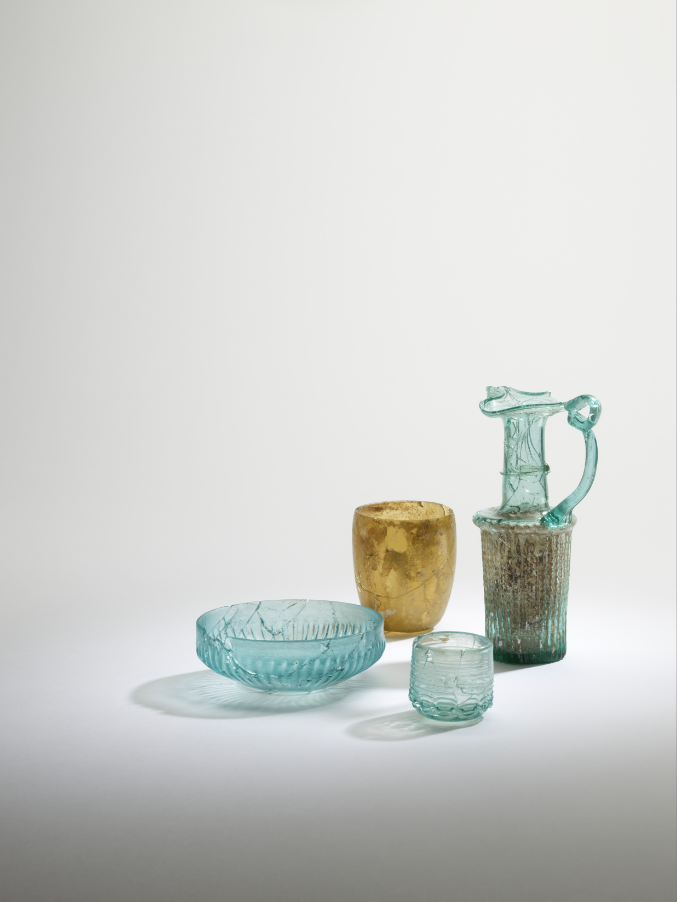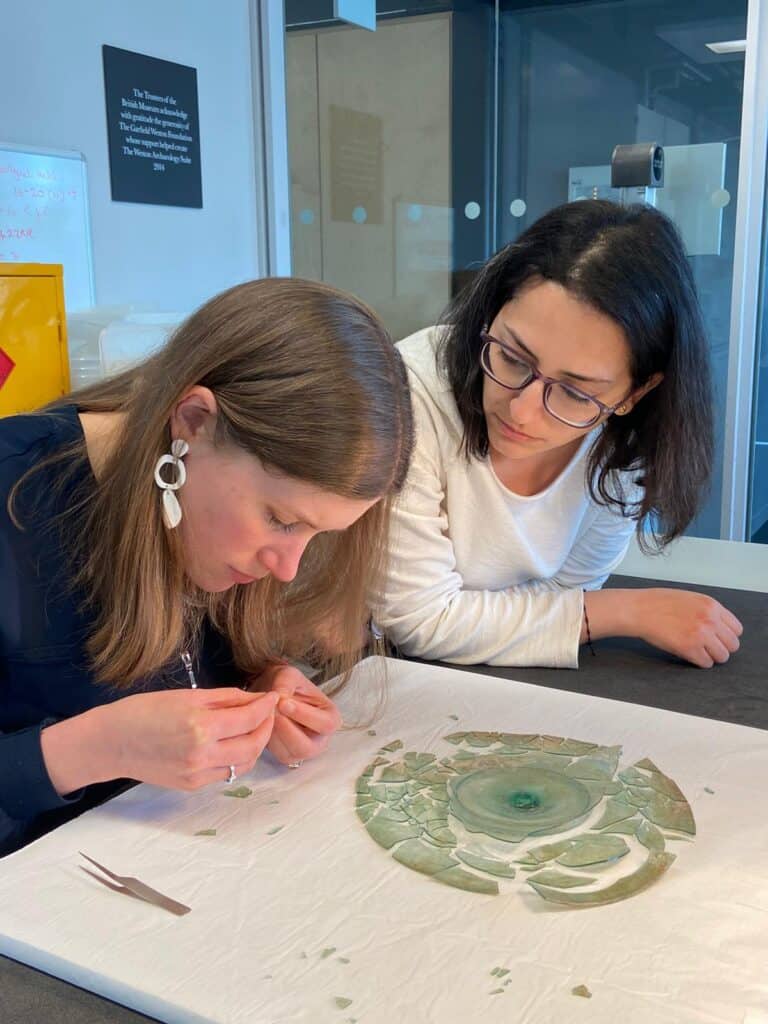
The British Museum is to exhibit eight ancient glass vessels which were damaged in the 2020 Beirut port explosion and newly conserved by experts. The beautiful vessels were painstakingly pieced back together and conserved at the conservation laboratories at the British Museum in London and will be shown as part of the Asahi Shimbun Display Shattered glass of Beirut before their return to Lebanon in late Autumn.
The display is the culmination of a collaborative conservation project between the British Museum and the Archaeological Museum of the American University in Beirut (AUB) which began in 2021.
The Asahi Shimbun Display Shattered glass of Beirut tells a story of near destruction and recovery, of resilience and collaboration. Two years on since the Beirut explosion, we are delighted to display these eight conserved ancient glass vessels. We are thankful for the dedicated work of colleagues from the AUB Archaeological Museum and the British Museum who have made this display possible.
Hartwig Fischer, Director of the British Museum
Situated 3km away from the explosion point, the AUB Museum sustained heavy damage to its windows and doors when the port explosion occurred in Lebanon Beirut on 4 August 2020. The case containing 74 vessels fell over from the force of the blast, shattering the glass objects inside: 72 glass vessels from the Roman, Byzantine and Islamic periods. To date, 18 vessels have been conserved as part of an emergency recovery campaign in Beirut in addition to the eight vessels at the British Museum. Miraculously, two of the vessels survived the fall in perfect condition. Conservators at the British Museum and AUB Museum hope that at least half of the remaining 46 objects in Beirut can be conserved soon.
Conservators at the British Museum and the AUB Museum agreed early in the process to conserve the vessels to be structurally sound but leave the imperfections caused by the shattering visible. The damage from the explosion is now part of the history of these delicate objects. Reflecting this decision, lighting will be used in the display to highlight the cracks and gaps in the glass. Like scars, these bear witness to the explosion and the determination of the people of Lebanon to recover and reconstruct.
Reconstructing these fragmented glass vessels one tiny bit at a time, helped to reunite, to recognize their heritage value, and to build a sense of community. To see these shattered and delicate vessels reassembled not only sparked a healing process, but also inspired me to hope for a better future.”
Dr Nadine Panayot, Curator of the AUB Archaeological Museum

The display will take the visitor on the same journey undergone by the glass vessels, from the moment of the explosion to their display in the exhibition space. To fully immerse viewers in this journey, the exhibit will consist primarily of audio-visual content using footage taken during the conservation process. Recorded interviews with staff from the AUB Museum and British Museum will integrate human voices into the display to express the emotional impact of the explosion and the response, resilience and recovery represented by the conservation of the vessels.
The conservation work also brings the potential for future research into the use of the objects. Dr Andrew Meek and Dr Joanne Dyer of the British Museum Scientific Research team have had opportunity to conduct analyses that can provide knowledge about the vessels’ manufacture and decoration that was unknown before their destruction in 2020. As the objects were broken, the internal surfaces of the vessels were accessible meaning researchers could analyse a ‘fresh’ glass surface. None of the vessels were originally coloured but a number of them contain very small quantities of elements associated with coloured (e.g. cobalt, copper) or opacified (e.g. lead, antimony) glass suggesting that they were produced using some recycled glass. Even at the birth of mass production, it was common practice to recycle broken glass reusing materials rather than throwing them away. This fascinating discovery helps researchers build a better picture of the actions of the glass producers and consumers. For a modern day viewer, it is incredible to see the startling similarities between today’s recycling practices and those c.2000 years ago.
The vessels conserved at the British Museum are hugely important in telling the story of the development of glass-blowing technology in Lebanon in the 1st century BC, a period which saw glass production revolutionised. This technique enabled the mass production of glass objects in different forms, making an elite material available for common, domestic use. Six of the eight vessels identified for conservation were made by early glass-blowing technology and show experimentation in function and form. Two other vessels date to the late Byzantine – early Islamic periods, and may have been imported to Lebanon from neighbouring glass manufacturing centres in Syria or Egypt.
The footage of the Beirut explosion came as a huge shock, and I replayed the images repeatedly in disbelief. Working with colleagues at the British Museum and at the Archaeological Museum in Beirut to piece together some of the artefacts that were shattered in the explosion has been an emotional journey, but also a meaningful small step in the preservation of Beirut’s heritage and pride and in the recovery of its citizens as they gradually rebuild their lives.
Zeina Klink-Hoppe, Curator at the British Museum
The Asahi Shimbun Displays Shattered glass of Beirut runs from 25th August to 23rd October in Room 3 at the British Museum. Open Saturday – Thursday 10.00–17.00, Friday 10.00–20.30.
The Asahi Shimbun Displays are a series of regularly changing displays which look at objects in new or different ways. Sometimes the display highlights a well-known item, sometimes it surprises the audience with extraordinary items from times and cultures that may not be very familiar. This is also an opportunity for the Museum to learn how it can improve its larger exhibitions and permanent gallery displays. These displays have been made possible by the generous sponsorship of The Asahi Shimbun Company, who are long-standing supporters of the British Museum. With a circulation of about 6 million for the morning edition alone, The Asahi Shimbun is the most prestigious newspaper in Japan. The company also publishes magazines and books, and provides a substantial information service on the Internet. The Asahi Shimbun Company has a century long tradition of staging exhibitions in Japan of art, culture and history from around the world.
This project is made possible by the TEFAF Museum Restoration Fund which was established in 2012 to support and promote the professional restoration and related scholarly research of significant museum artworks. Championing art in all its forms, each year TEFAF awards grants to one or two museums around the world to restore artworks from across the ages. A Committee of independent experts selects the winners, whose work in restoration is a remarkable contribution to the field of art history. Visit www.tefaf.com/stories to learn about restorations TEFAF has supported in the last nine years.







